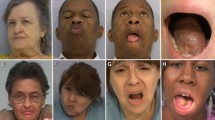Abstract
An examination of tardive dyskinesia in 213 schizophrenic outpatients using the Abnormal Involuntary Movement Scale (AIMS) indicates that increasing age is significantly associated with the presence of this disorder while sex is not. Both sexes showed significant linear increases with increasing age. Although males did not evidence the statistically significant curvilinear trend previously reported in an inpatient study using the same methodology, they displayed an attenuated effect at the older age levels. A comparison of prevalence values between the out-patient sample and the inpatient sample previously studied indicated no greater prevalence in the out-patients. However, an examination of differences in AIMS total scores between these samples suggested the presence of many more marginal and mild movements in the outpatients. Reasons for the differences between the inpatient and outpatient studies are discussed.
Similar content being viewed by others
References
Asnis, G. M., Leopold, M. A., Duvoisin, R. C., Schwartz, A. H.: A survey of tardive dyskinesia in psychiatric outpatients. Am. J. Psychiatry 134, 1367–1370 (1977)
Brandon, S., McClelland, H. A., Protheroe, C.: A study of facial dyskinesia in a mental hospital population. Br. J. Psychiatry 118, 171–184 (1971)
Chien, C.-P., Jung, K., Ross-Townsend, A., Stearns, B.: The measurement of persistent dyskinesia by piezoelectric recording and clinical rating scales. Psychopharmacol. Bull. 13, 34–36 (1977)
Coopersmith, S.: The antecedents of self-esteem, pp. 265–266. San Francisco: Freeman 1967
Crane, G. E.: Tardive dyskinesia in schizophrenic patients treated with psychotropic drugs. Agressologie 9, 209–216 (1968a)
Crane, G. E.: Dyskinesia and neuroleiptics. Arch. Gen. Psychiatry 19, 700–703 (1968b)
Crane, G. E., Paulson, G.: Involuntary movements in a sample of chronic mental patients and their relation to the treatment with neuroleptics. Int. J. Neuropsychiatry 3, 286–291 (1967)
Demars, J.-P.: Neuromuscular effects of long-term phenothiazine medication, electroconvulsive therapy and leucotomy. J. Nerv. Ment. Dis. 143, 73–79 (1966)
Dinemen, K.: Chronic psychotic choreo-athetosis. Dis. Nerv. Syst. 27, 399–402 (1966)
Dynes, J. B.: Oral dyskinesias: Occurrence and treatment. Dis. Nerv. Syst. 31, 854–859 (1970)
Edwards, H.: The significance of brain damage in persisten oral dyskinesia. Br. J. Psychiatry 116, 271–275 (1970)
Ettinger, M., Curran, J.: Liver disease and phenothiazines. Minn. Med. 53, 731–736 (1970)
Faurbye, A., Rasch, P.-J., Petersen, P. B., Brandborg, G., Pakkenberg, H.: Neurological symptoms in pharmacotherapy of psychoses. Acta Psychiatr. Scand. 40, 10–27 (1964)
Gardos, G., Cole, J. O., Tarsy, D.: Withdrawal syndromes associated with antipsychotic drugs. Am. J. Psychiatry 135, 1321–1324 (1978)
Guy, W.: ECDEU assessment manual for psychopharmacology, pp. 534–537. Washington D. C.: DHEW 1976
Honigfeld, G., Gillis, R. D., Klett, C. J.: NOSIE-30: A treatment-sensitive ward behavior scale. Psychol. Rep. 19, 180–182 (1966)
Hunter, R., Earl, C. J., Thornicroft, S.: An apparently irreversible syndrome of abnormal movements following phenothiazine medication. Proc. R. Soc. Med. 57, 758–762 (1964)
Kazamatsuri, H., Chien, C.-P., Cole, J. O.: Therapeutic approaches to tardive dyskinesia. Arch. Gen. Psychiatry 27, 491–499 (1972)
Kennedy, P. F., Hershon, H. I., McGuire, R. J.: Extrapyramidal disorders after prolonged phenothiazine therapy. Br. J. Psychiatry 118, 509–518 (1971)
Pryce, I. G., Edwards, H.: Persistent oral dyskinesia in female mental hospital patients. Br. J. Psychiatry 112, 983–987 (1966)
Siede, H., Müller, H. F.: Choreiform movements as side effects of phenothiazine medication in geriatric patients. J. Am. Geriatr. Soc. 15, 517–522 (1967)
Smith, J. M., Kucharski, L. T., Oswald, W. T., Waterman, L. J.: A systematic investigation of tardive dyskinesia in inpatients. Am. J. Psychiatry (in press, 1979)
Smith, J. M., Oswald, W. T., Kucharski, L. T., et al.: Tardive dyskinesia: Age and sex differences in hospitalized schizophrenics. Psychopharmacology 58, 207–211 (1978)
Turunen, S., Achté, K. A.: The bucco-linguo-masticatory syndrome as a side effect of neuroleptic therapy. Psychiatr. Q. 41, 268–279 (1967)
Wyatt, R. J.: Biochemistry and schizophrenia. The neuroleptics: Their mechanism of action. A review of the biochemical literature. Psychopharmacol. Bull. 12, 5–50 (1976)
Author information
Authors and Affiliations
Additional information
At the time of the study, Mr. Eblen, Mr. Knutsen, and Mr. Linn were graduate interns from the Community Psychology program at Marist College, Poughkeepsie, N. Y.
Rights and permissions
About this article
Cite this article
Smith, J.M., Kucharski, L.T., Eblen, C. et al. An assessment of tardive dyskinesia in schizophrenic outpatients. Psychopharmacology 64, 99–104 (1979). https://doi.org/10.1007/BF00427353
Received:
Accepted:
Issue Date:
DOI: https://doi.org/10.1007/BF00427353




